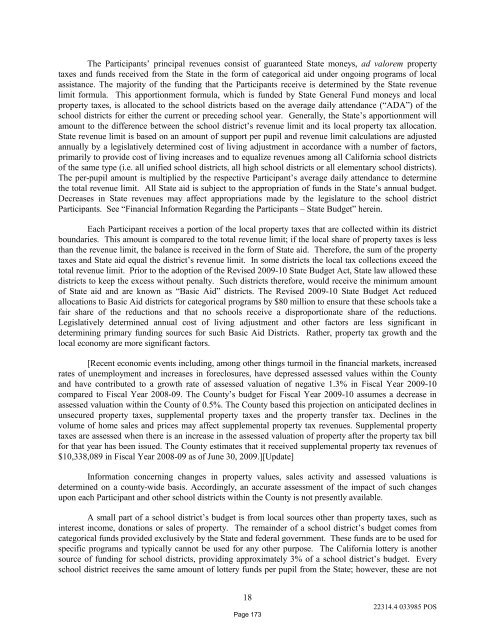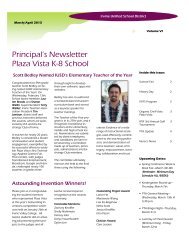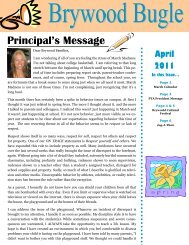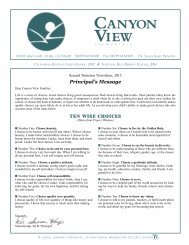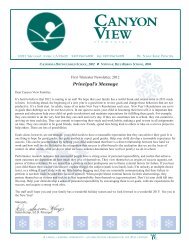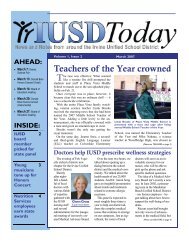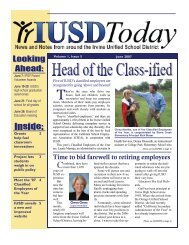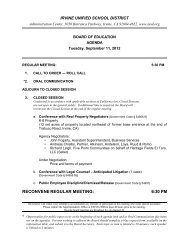reconvene regular meeting: 7:00 pm - Irvine Unified School District
reconvene regular meeting: 7:00 pm - Irvine Unified School District
reconvene regular meeting: 7:00 pm - Irvine Unified School District
You also want an ePaper? Increase the reach of your titles
YUMPU automatically turns print PDFs into web optimized ePapers that Google loves.
The Participants’ principal revenues consist of guaranteed State moneys, ad valorem property<br />
taxes and funds received from the State in the form of categorical aid under ongoing programs of local<br />
assistance. The majority of the funding that the Participants receive is determined by the State revenue<br />
limit formula. This apportionment formula, which is funded by State General Fund moneys and local<br />
property taxes, is allocated to the school districts based on the average daily attendance (“ADA”) of the<br />
school districts for either the current or preceding school year. Generally, the State’s apportionment will<br />
amount to the difference between the school district’s revenue limit and its local property tax allocation.<br />
State revenue limit is based on an amount of support per pupil and revenue limit calculations are adjusted<br />
annually by a legislatively determined cost of living adjustment in accordance with a number of factors,<br />
primarily to provide cost of living increases and to equalize revenues among all California school districts<br />
of the same type (i.e. all unified school districts, all high school districts or all elementary school districts).<br />
The per-pupil amount is multiplied by the respective Participant’s average daily attendance to determine<br />
the total revenue limit. All State aid is subject to the appropriation of funds in the State’s annual budget.<br />
Decreases in State revenues may affect appropriations made by the legislature to the school district<br />
Participants. See “Financial Information Regarding the Participants – State Budget” herein.<br />
Each Participant receives a portion of the local property taxes that are collected within its district<br />
boundaries. This amount is compared to the total revenue limit; if the local share of property taxes is less<br />
than the revenue limit, the balance is received in the form of State aid. Therefore, the sum of the property<br />
taxes and State aid equal the district’s revenue limit. In some districts the local tax collections exceed the<br />
total revenue limit. Prior to the adoption of the Revised 2<strong>00</strong>9-10 State Budget Act, State law allowed these<br />
districts to keep the excess without penalty. Such districts therefore, would receive the minimum amount<br />
of State aid and are known as “Basic Aid” districts. The Revised 2<strong>00</strong>9-10 State Budget Act reduced<br />
allocations to Basic Aid districts for categorical programs by $80 million to ensure that these schools take a<br />
fair share of the reductions and that no schools receive a disproportionate share of the reductions.<br />
Legislatively determined annual cost of living adjustment and other factors are less significant in<br />
determining primary funding sources for such Basic Aid <strong>District</strong>s. Rather, property tax growth and the<br />
local economy are more significant factors.<br />
[Recent economic events including, among other things turmoil in the financial markets, increased<br />
rates of unemployment and increases in foreclosures, have depressed assessed values within the County<br />
and have contributed to a growth rate of assessed valuation of negative 1.3% in Fiscal Year 2<strong>00</strong>9-10<br />
compared to Fiscal Year 2<strong>00</strong>8-09. The County’s budget for Fiscal Year 2<strong>00</strong>9-10 assumes a decrease in<br />
assessed valuation within the County of 0.5%. The County based this projection on anticipated declines in<br />
unsecured property taxes, supplemental property taxes and the property transfer tax. Declines in the<br />
volume of home sales and prices may affect supplemental property tax revenues. Supplemental property<br />
taxes are assessed when there is an increase in the assessed valuation of property after the property tax bill<br />
for that year has been issued. The County estimates that it received supplemental property tax revenues of<br />
$10,338,089 in Fiscal Year 2<strong>00</strong>8-09 as of June 30, 2<strong>00</strong>9.][Update]<br />
Information concerning changes in property values, sales activity and assessed valuations is<br />
determined on a county-wide basis. Accordingly, an accurate assessment of the impact of such changes<br />
upon each Participant and other school districts within the County is not presently available.<br />
A small part of a school district’s budget is from local sources other than property taxes, such as<br />
interest income, donations or sales of property. The remainder of a school district’s budget comes from<br />
categorical funds provided exclusively by the State and federal government. These funds are to be used for<br />
specific programs and typically cannot be used for any other purpose. The California lottery is another<br />
source of funding for school districts, providing approximately 3% of a school district’s budget. Every<br />
school district receives the same amount of lottery funds per pupil from the State; however, these are not<br />
18<br />
Page 173<br />
22314.4 033985 POS


